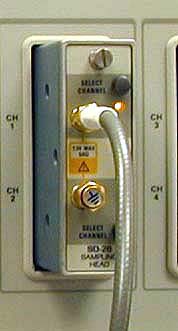
|
|
The Tektronix SD26 is a dual-channel Sampling Head. This sampling head has a rise time of 17.5 ps or less, with a typical 20 GHz equivalent-time bandwidth. The input impedance of the SD26 is 50 ohms, and the maximum safe input voltage is ±3 V. The SD26 can be inserted into an 11801, 11802, SM11, or they can be attached to Sampling Head Extender Cables. Dot Transient Response: Adjustable to ±5% for signals from 0 to 0.5 V p-p; adjustable to unity for signals from 0.5 V to 1.0 V p-p. Input Termination: 50 ±0.5 ohm. Displayed Noise: With unity dot response typically 1.3 mV RMS; with smoothing: typically 0.6 mV RMS. Max (Nondestructive) Input Voltage: ± 3.0 V. Rise Time: <=17.5 ps. Bandwidth: >= 20 GHz typical. Time Coincidence Between Channels: <=10 ps. Dynamic Range:1 V p-p within a ±1.6 V range.
|